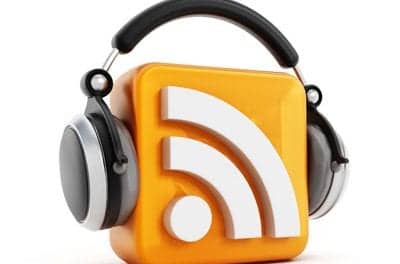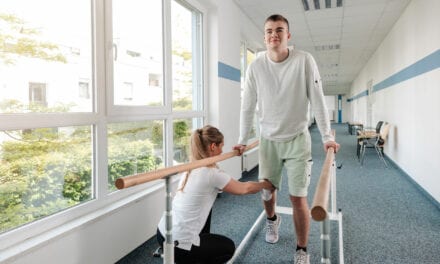Detecting the source of deficits in older adults with vestibular disorder post-stroke bridges the gap between a silent, life-altering condition and improved function.
By: Brittan West
In aging bodies, decreased elasticity yields a slow and deteriorating effect on daily function. Yet it is neurologically compromised internal circuitry tucked deep within the human central nervous system that is the cause of many conditions that disrupt daily function among individuals of all ages.
One event that can short-circuit the neurological systems is a stroke, which hinders the ability to process inner ear information, and results in a central vestibular disorder. The disorder commonly surfaces following a stroke in the posterior circulation, termed “vertebrobasilar insufficiency.” Deficits left by a brain stem or cerebellar stroke can ultimately stand as an obstacle to processing vestibular information. Just as challenging though—and typically presenting without significant dizziness—are strokes that assault the anterior circulation. Because of this, it is vital for therapists to determine the location of a patient’s lesion and pinpoint whether the deficits can be attributed to the stroke.
Challenges for Older Adults Post-Stroke
Patients who have other forms of stroke and present coincidentally with a vestibular disorder as a comorbidity are commonplace, says Jeff Walter, PT, DPT, NCS, director of the Otolaryngology Vestibular and Balance Center at Geisinger Medical Center in Danville, Pa. “Vestibular issues for those patients become more problematic when they also have to deal with weakness or incoordination or sensory issues from a stroke,” Walter says.
While vestibular disorders exist as a shared thread in a complex tapestry of poststroke comorbidities, a therapist may need to make special considerations for treating older adults after stroke. These include severe arthritic changes of the neck, and a resulting decreased range of motion.
“Members of this population tend to not move their heads very much, so they don’t get a lot of the vestibular input,” says Sue Golden, PT, director of the Neurorehabilitation Program at the Allentown, Pa-based Good Shepherd Rehabilitation Network. She adds, “Prior to stroke, they have decreased sensation in their feet sometimes from peripheral vascular disease or other types of issues, so their balance system is already compromised even before they had the stroke.”
Beyond physicality, trust can prove a daunting psychological barrier between the therapist and the older adult patient. Nicole Smith, PT, Good Shepherd Rehabilitation Network, says to improve the vestibular system of this patient population, therapists may have to challenge their patients. “Sometimes their symptoms might get a little bit worse before they start to get better. So gaining a patient’s trust is an important thing,” Smith notes.
An older adult patient’s trust may have been compromised by fear of discomfort, or by fall-related trauma resulting from balance impairment, spurred by underlying deficits in the integration of the central nervous system (visual, somatosensory, and vestibular). Additionally, muscle weakness resulting from lack of use can be a contributing factor to the impairment, leading to a higher incidence of falls in the older poststroke population.
Joanna Garlitos, PT, CHRISTUS St. Michael Rehabilitation Hospital in Texarkana, Tex, points to recent research that indicates a decrease in somatosensory afferent stimulation limits the individual in regulating the stimulus, resulting in loss of balance.1 A loss of balance in the upright position or “pusher syndrome” also may occur in strokes involving the posterolateral thalamus, and parts of the insula and postcentral gyrus, while the visual-vestibular processing may still remain intact.2
Garlitos also cites research highlighting lesions in the brain involving the middle cerebral artery and their ability to cause contraversive tilts of perceived vertical, body lateropulsion, and rarely rotational vertigo.3 Hemiparesis as a result of stroke, and other perceptual deficits such as agnosia, hemi-neglect, visual field cuts, and hemianopsia, are additional players in loss of balance.
Treatments: Tried, True, and New
Considerations that address vestibular issues among older adult patients after stroke may be unique to that population. However, technologies used to screen and treat vestibular dysfunction among stroke survivors are found in both conventional and developing therapeutic interventions.
Compensation and adaptation are two key spokes that help move the wheels of therapy toward restoration of normal movement and function after stroke. “This means treating the stroke survivor in the upright position to restore vertical-upright orientation,” explains Garlitos. “Exercises in sitting need to be initiated at first, using a vertical reference such as the therapist’s hands and legs, wedges, and bolsters. [Patients] may then be progressed to standing against the wall corner, against a wall, parallel bars, then finally limited or without support.”
The head may be moved slowly through a full range of motion in all planes with the eyes open and closed in a seated position before standing. Head movements can be made progressively faster while the patient is moving the upper extremities or lower extremities during sitting, standing, or ambulating. Garlitos also notes that some consideration may be made regarding the assistive device the individual is using to prevent falls. To address the somatosensory component, the patient’s stance can be narrowed progressively from half-tandem to full-tandem with the eyes open and closed.
Balance Technologies
Balance management systems built to provide objective assessment of balance control and postural stability under dynamic test conditions can play a vital role in treatment, allowing the therapist to measure and train patients. Tools that may be used to correct or challenge vertical position include a biomedical ankle platform system (BAPS) or a balance ball trainer intended to strengthen and coordinate core muscles.
Additionally, “We use a whole host of foam pads, hurdles, [and] puzzles that we have them look at as they move their head,” Golden says. In the presence of benign paroxysmal positional vertigo (BPPV), treatment may need to be adapted and wedges may be used.
“To accommodate for their loss of cervical and thoracic extension, a wedge is helpful,” Smith explains.
Visual Component
When addressing the visual component of vestibular rehabilitation, focus is directed toward gaze stabilization exercises that aim to improve visual acuity during dynamic activities. Video infrared goggles are one of the key tools used in the visual component of vestibular rehabilitation. The goggles are engineered to allow the therapist to assess patients for nystagmus, frequently present in patients with vestibular disorder.
The patterns of nystagmus provide a clinical road map that illustrates the distinction between a central or peripheral vestibular disorder and highlights a clearer route for treatment. The goggles also can be used to pinpoint BPPV.
With video infrared goggles, the eye can be viewed on a video screen, and, once it is magnified, the therapist can tune in to subtle defects with the patient.
Frenzel lenses also can be used during vestibular rehabilitation. The use of the lenses calls for direct observation by the examiner through the lenses.
To further establish peripheral vestibular loss, caloric testing has traditionally been utilized to further assess the patient for asymmetric peripheral vestibular dysfunction, according to Walter. A rotational chair can be used as an alternate test. Walter explains that this device “can be selectively helpful in establishing whether the patient has a loss of vestibular function bilaterally.”
New Testing Technology
An emerging test being offered as a solution to quickly assess whether a patient has normal vestibular function is video head impulse testing. While the technology is still under development, “it holds promise to be a quick and painless test,” Walter says. He adds that the test may one day serve as an alternative or complement to caloric testing.
If necessary, specific therapeutic customization can be added to the vestibular rehabilitation equation, employing activities that can be modified for the older adult patient post-stroke. These include supine to sitting activities while turning the head with the eyes fixed on a target. Conventional physical therapy blended with balance training using a popular video gaming system also has exhibited results that led to improvement in body symmetry, balance, and function.4 Garlitos notes that additional video gaming systems have yielded promising results as a nonconventional adjunct to balance training, and are entertaining to participants in a variety of age brackets.
Addressing Anxiety
While often an undesired by-product of a vestibular disorder, a patient’s struggle with anxiety as a preexisting condition to the onset of stroke and vestibular disorder may lead them to be highly sensitive to dysfunction. In patients with a vestibular disorder and preexisting anxiety, excessive dependence upon vision for balance can translate into a significant hardship, resulting from increased saccadic activity.
Fragmented understanding of vestibular disorders in primary care also can contribute to persistent anxiety in patients of all ages and ultimately limit activities of daily living (ADLs) following the onset of symptoms. Frequently, a patient’s symptoms may be attributed to vertigo, “but the origin of it is never really explained to the patients,” Walter says. The misattribution of symptoms and obscured symptom etiology serves to magnify this anxiety.
Additionally, “There’s an interesting marriage that’s not completely well understood between anxiety and dizziness. There’s some emerging evidence that if you have a vestibular disorder, you’re more sensitive to it if you struggle with anxiety,” Walter points out.
This reliance on vision, whether it stems from preexisting or newly developed anxiety, is another component of vestibular rehabilitation that calls for vigilance on the therapist’s part to assess vision and the eyes’ ability to coordinate with one another. This is particularly key since “…quite often someone has a stroke and has a field neglect or a mid-line shift or trouble coordinating their eyes together; their balance is already going to be off,” Golden states, and despite enduring efforts to “pull in the vestibular system…they’re still going to be at risk for falls.”
A careful review of a patient’s unique history, Smith adds, allows therapists to “really ask how these exercises are affecting them in terms of symptoms and mobility at home,” reinforcing communication between therapist and patient to ensure all needs are being addressed.
Healthy Communication
A litany of trusted treatments and screenings are available to treat older adults and members of the stroke population at large. Among the greatest therapeutic interventions leading the battle against vestibular disorders is a stable line of communication between therapist and patient. It is this communication that bridges the gap between a silent yet life-altering condition and improved function for individuals at every age. RM
Brittan West is associate editor for Rehab Management. For more information, contact [email protected].





